The Madden-Julian Oscillation: A Tool for Regional Seasonal Precipitation Outlooks?
Abstract
:1. Introduction
2. Data and Methods
3. Results
3.1. MJO and Global Precipiation
3.2. MJO and Extratropical Land Precipitation
4. Discussion
5. Conclusions
Acknowledgments
Conflicts of Interest
References
- Zhang, C. Madden-Julian oscillation: Bridging weather and climate. Bull. Am. Meteorol. Soc. 2013, 94, 1849–1870. [Google Scholar] [CrossRef]
- Marshall, A.G.; Hudson, D.; Wheeler, M.C.; Hendon, H.H.; Alves, O. Assessing the simulation and prediction of rainfall associated with the MJO in the POAMA seasonal forecast system. Clim. Dyn. 2011, 37, 2129–2141. [Google Scholar] [CrossRef]
- Vitart, F.; Molteni, F. Simulation of the Madden-Julian oscillation and its teleconnections in the ECMWF forecast system. Quart. J. R. Meteorol. Soc. 2010, 136, 842–855. [Google Scholar] [CrossRef]
- Wheeler, M.C.; Hendon, H.H. An all-season real-time multivariate MJO index: Development of an index for monitoring and prediction. Mon. Weather Rev. 2004, 132, 1917–1932. [Google Scholar] [CrossRef]
- Jones, C.; Waliser, D.E.; Lau, K.M.; Stern, W. Global occurrences of extreme precipitation and the Madden-Julian oscillation: Observations and predictability. J. Clim. 2004, 17, 4575–4589. [Google Scholar] [CrossRef]
- Donald, A.; Meinke, H.; Power, B.; Maia, A.D.H.N.; Wheeler, M.C.; White, N.; Stone, R.C.; Ribbe, J. Near-global impact of the Madden-Julian oscillation on rainfall. Geophys. Res. Lett. 2006, 33, L09704. [Google Scholar] [CrossRef]
- Curtis, S.; Gamble, D.W. The boreal winter Madden-Julian oscillation’s influence on summertime precipitation in the greater Caribbean. J. Geophys. Res. Atmos. 2016, 121, 7592–7605. [Google Scholar] [CrossRef]
- Alexander, M.A.; Bladé, I.; Newman, M.; Lanzante, J.R.; Lau, N.C.; Scott, J.D. The atmospheric bridge: The influence of ENSO teleconnections on air-sea interaction over the global oceans. J. Clim. 2002, 15, 2205–2231. [Google Scholar] [CrossRef]
- Branstator, G. Circumglobal teleconnections, the jet stream wave guide, and the North Atlantic Oscillation. J. Clim. 2002, 15, 1893–1910. [Google Scholar] [CrossRef]
- Lin, H.; Brunet, G.; Derome, J. Interannual variability of the Madden-Julian Oscillation and its impact on the North Atlantic Oscillation in the boreal winter. Geophys. Res. Lett. 2015, 42, 5571–5576. [Google Scholar] [CrossRef]
- Lu, W.; Hsu, P.C. Factors controlling the seasonality of the Madden-Julian Oscillation. Dyn. Atmos. Oceans 2017, 78, 106–120. [Google Scholar] [CrossRef]
- Wolter, K.; Timlin, M.S. Measuring the strength of ENSO events—How does 1997/98 rank? Weather 1998, 53, 315–324. [Google Scholar] [CrossRef]
- Adler, R.F.; Huffman, G.J.; Chang, A.; Ferraro, R.; Xie, P.; Janowiak, J.; Rudolf, B.; Schneider, U.; Curtis, S.; Bolvin, D.; et al. The version 2 Global Precipitation Climatology Project (GPCP) monthly precipitation analysis (1979–present). J. Hydrometeor. 2003, 4, 1147–1167. [Google Scholar] [CrossRef]
- GPCP V2.3 Monthly Analysis Product. Available online: eagle1.umd.edu/GPCP_ICDR/GPCP_Monthly.html (accessed on 24 July 2017).
- Becker, A.; Finger, P.; Meyer-Christoffer, A.; Rudolf, B.; Schamm, K.; Schneider, U.; Ziese, M. A description of the global land-surface precipitation data products of the Global Precipitation Climatology Centre with sample applications including centennial (trend) analysis from 1901–present. Earth Syst. Sci. Data 2013, 5, 71–99. [Google Scholar] [CrossRef]
- Livezey, R.E.; Chen, W.Y. Statistical field significances and its determination by Monte Carlo techniques. Mon. Weather Rev. 1983, 111, 46–59. [Google Scholar] [CrossRef]
- Zhang, C.; Dong, M. Seasonality in the Madden-Julian oscillation. J. Clim. 2004, 16, 3169–3180. [Google Scholar] [CrossRef]
- Lawrence, D.M.; Webster, P.J. The boreal summer intraseasonal oscillation: Relationship between northward and eastward movement of convection. J. Atmos. Sci. 2002, 59, 1593–1606. [Google Scholar] [CrossRef]
- Adames, Á.F.; Wallace, J.M.; Monteiro, J.M. Seasonality of the structure and propagation characteristics of the MJO. J. Atmos. Sci. 2016, 73, 3511–3526. [Google Scholar] [CrossRef]
- Ding, Q.; Wang, B. Circumglobal teleconnection in the Northern Hemisphere summer. J. Clim. 2005, 18, 3483–3505. [Google Scholar] [CrossRef]
- Curtis, S.; Adler, R.F. The evolution of El Niño-precipitation relationships from satellites and gauges. J. Geophys. Res. Atmos. 2003, 108, 4153. [Google Scholar] [CrossRef]
- Hendon, H.H.; Wheeler, M.C.; Zhang, C. Seasonal dependence of the MJO-ENSO relationship. J. Clim. 2007, 20, 531–543. [Google Scholar] [CrossRef]
- Seiki, A.; Takayabu, Y.N. Westerly wind bursts and their relationship with intraseasonal variations and ENSO. Part 1: Statistics. Mon. Weather Rev. 2007, 135, 3325–3345. [Google Scholar] [CrossRef]
- Tang, Y.; Yu, B. MJO and its relationship to ENSO. J. Geophys. Res. Atmos. 2008, 113, D14106. [Google Scholar] [CrossRef]
- Moon, J.Y.; Wang, B.; Ha, K.J. ENSO regulation of MJO teleconnection. Clim. Dyn. 2011, 37, 1133–1149. [Google Scholar] [CrossRef]
- Zhang, C.; Gottschalck, J. SST anomalies of ENSO and the Madden-Julian oscillation in the equatorial Pacific. J. Clim. 2002, 15, 2429–2445. [Google Scholar] [CrossRef]
- KNMI Climate Explorer. Available online: https://climexp.knmi.nl (accessed on 18 September 2017).
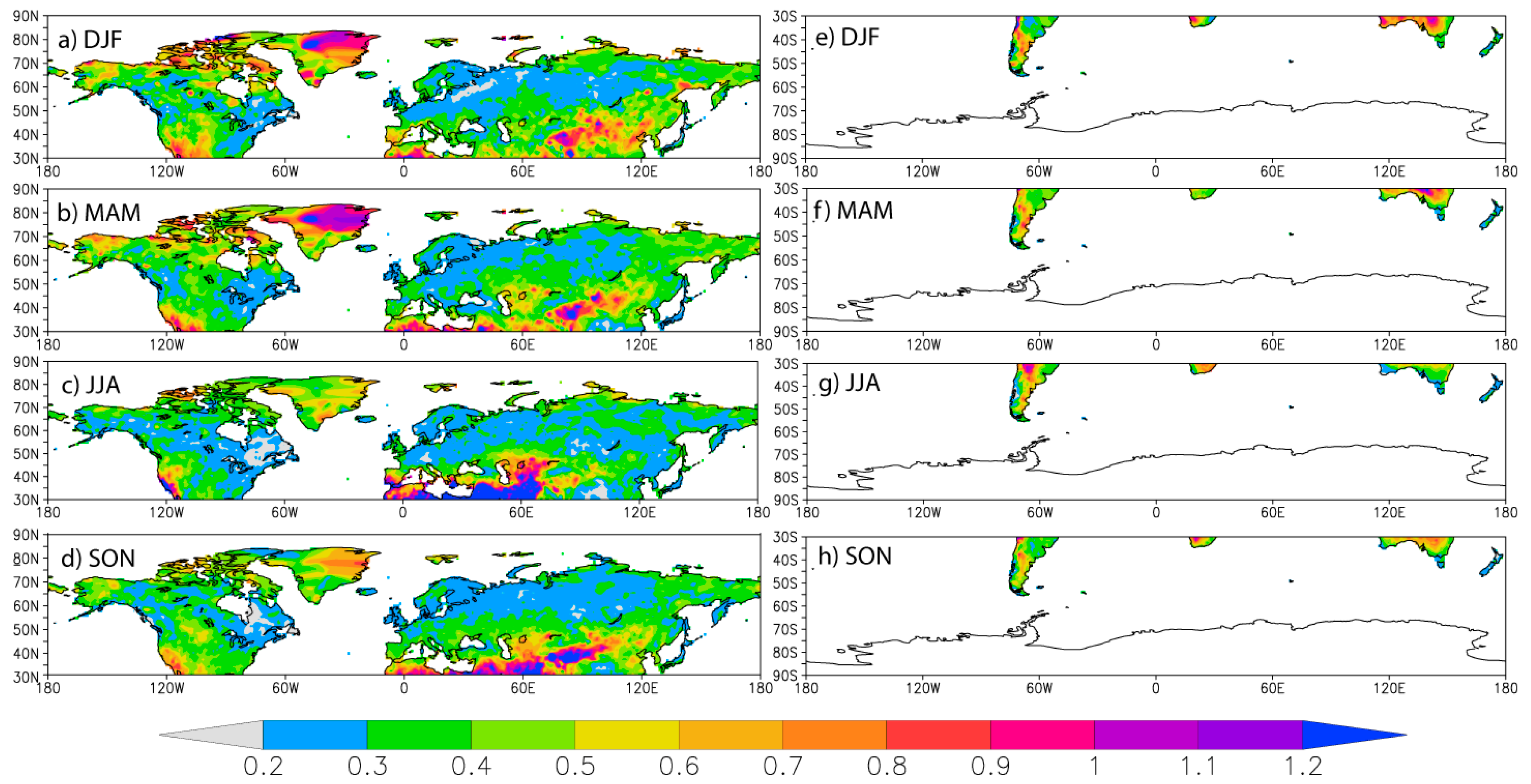
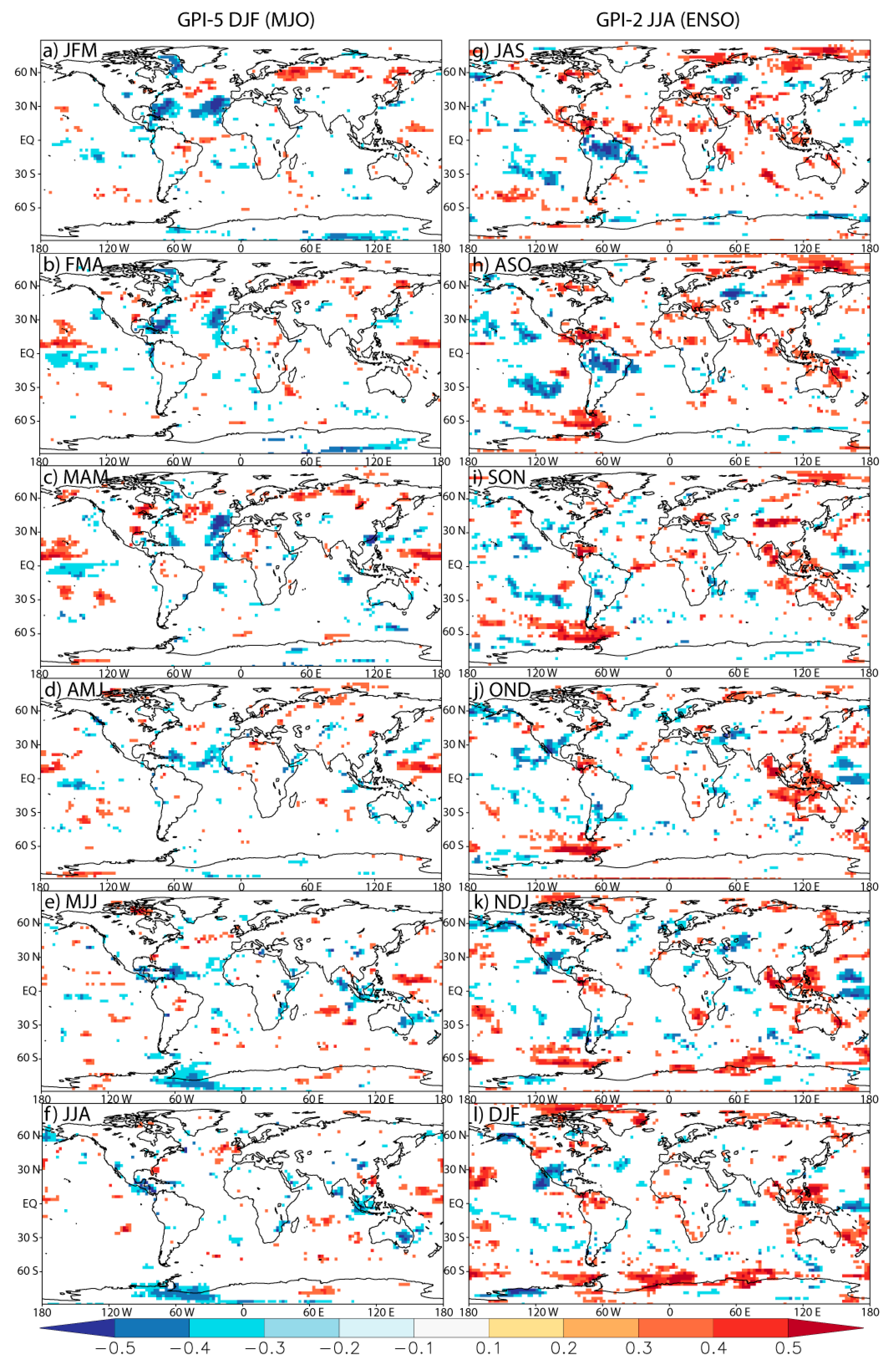
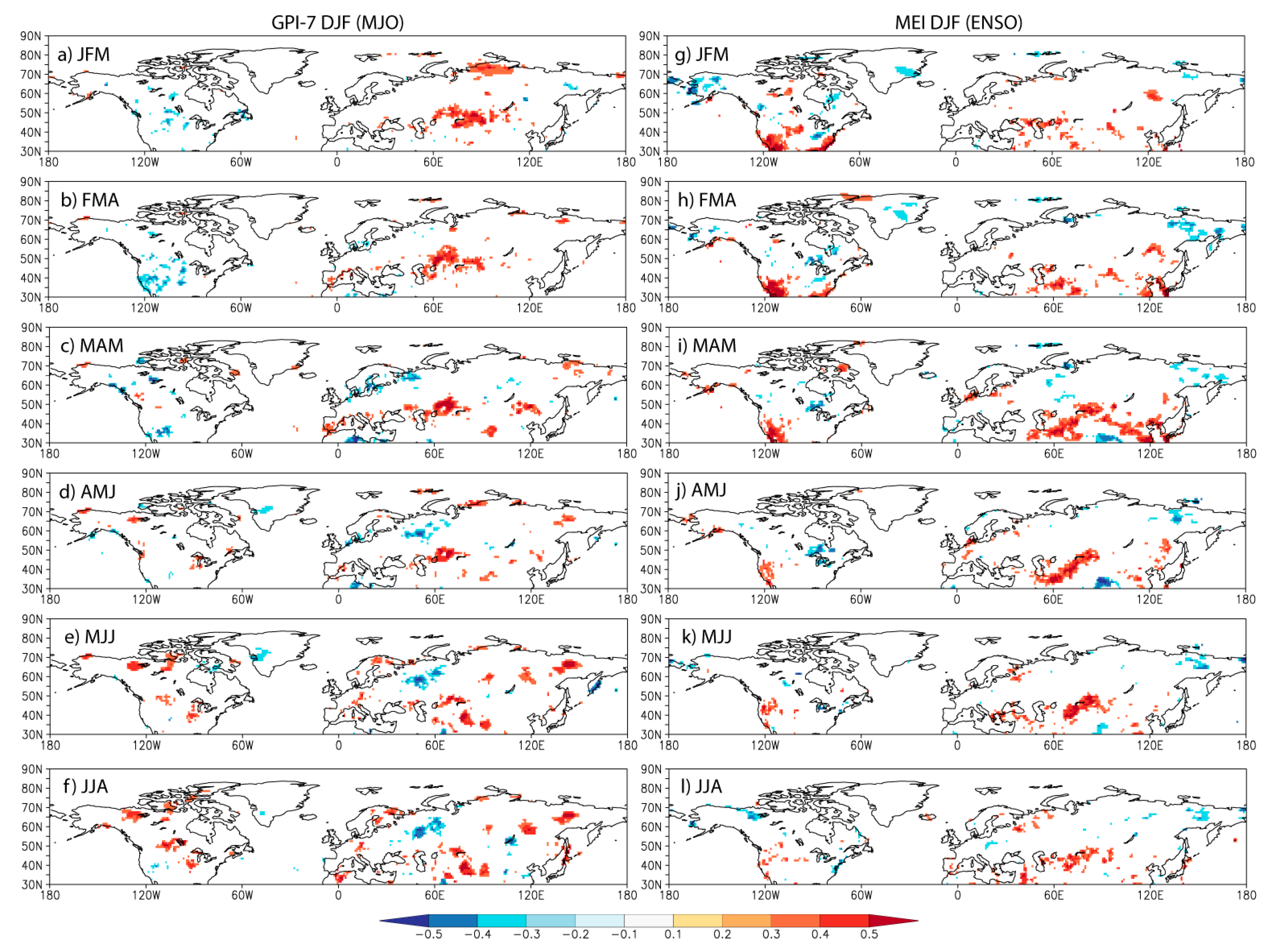
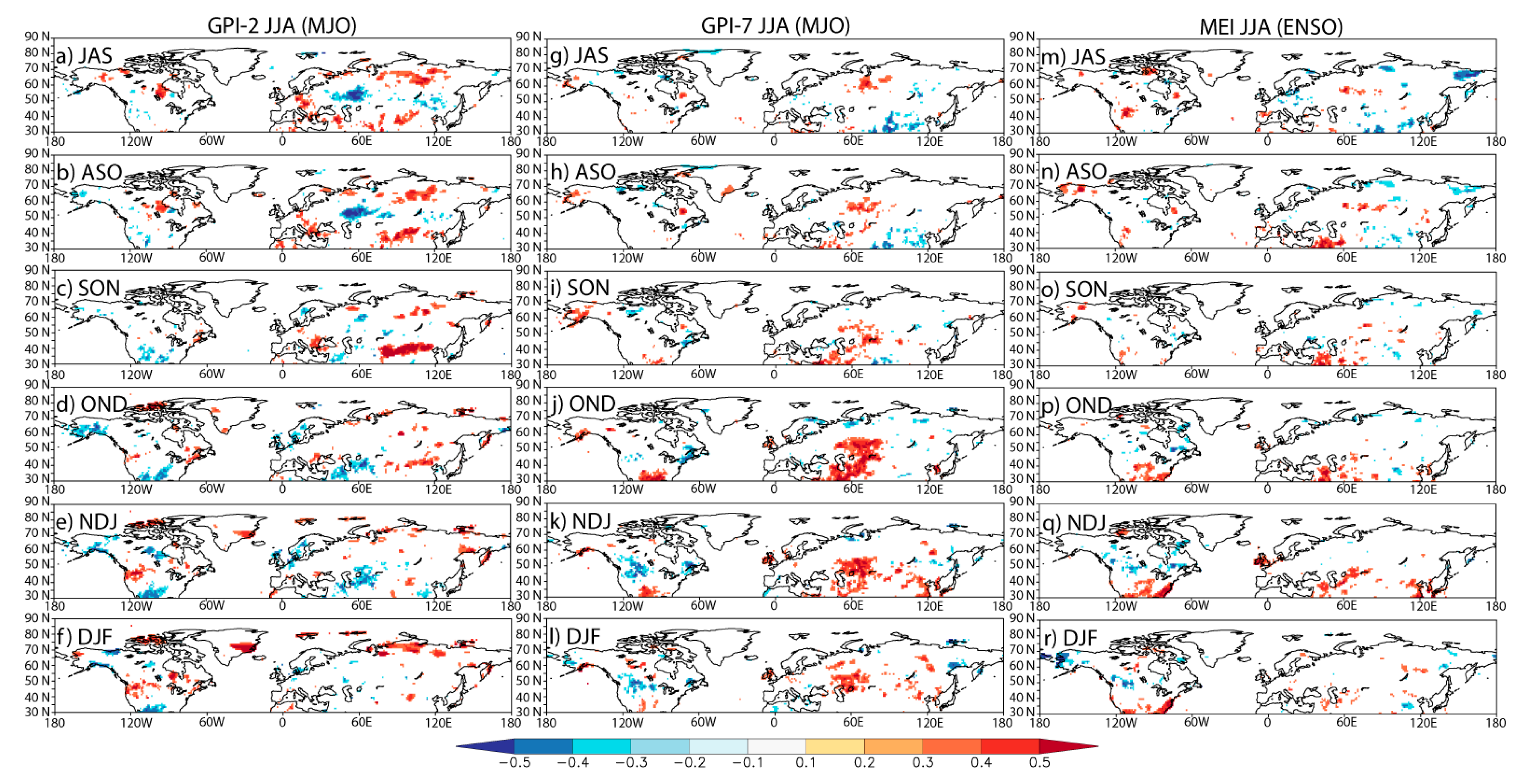
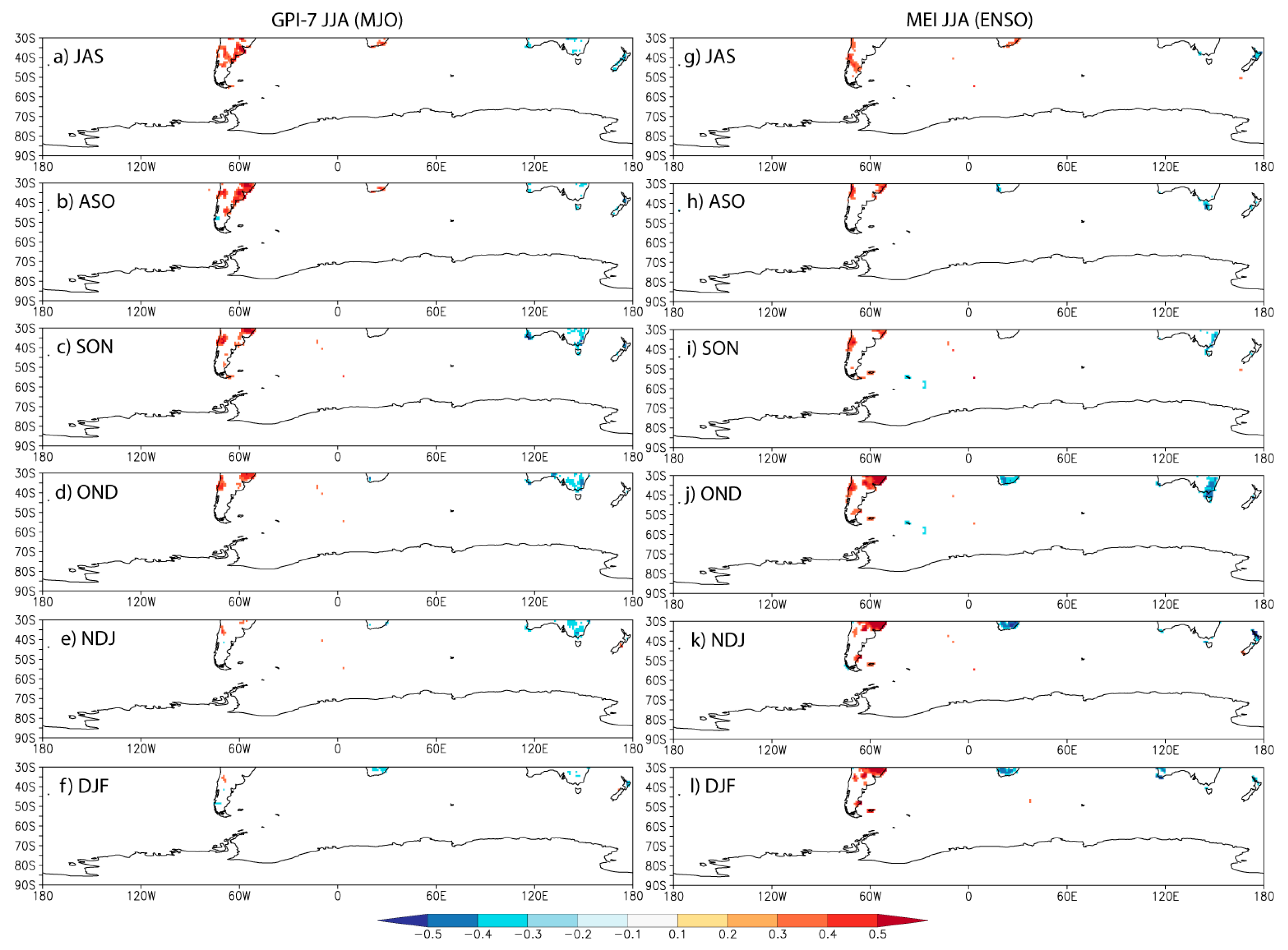
| DJF | JFM | FMA | MAM | AMJ | MJJ | JJA |
|---|---|---|---|---|---|---|
| GPI-1 | 3.23 | 3.50 | 3.58 | 3.24 | 4.22 | 4.22 |
| GPI-2 | 4.71 | 4.22 | 5.55 | 5.68 | 6.02 | 6.03 |
| GPI-3 | 5.66 | 4.77 | 4.59 | 4.90 | 5.08 | 3.55 |
| GPI-4 | 3.37 | 2.95 | 3.79 | 4.51 | 3.68 | 3.25 |
| GPI-5 | 7.69 1 | 9.03 2 | 10.68 3 | 7.79 2 | 8.68 2 | 6.88 |
| GPI-6 | 7.16 1 | 8.16 2 | 5.94 | 6.12 | 7.84 2 | 9.19 3 |
| GPI-7 | 4.59 | 5.94 | 6.25 | 5.92 | 6.07 | 6.03 |
| GPI-8 | 5.32 | 4.44 | 3.96 | 2.75 | 4.28 | 2.94 |
| MEI | 29.21 3 | 26.83 3 | 23.30 3 | 21.60 3 | 17.22 3 | 11.05 3 |
| JJA | JAS | ASO | SON | OND | NDJ | DJF |
|---|---|---|---|---|---|---|
| GPI-1 | 9.31 3 | 8.38 2 | 7.88 2 | 7.18 1 | 6.32 1 | 7.09 1 |
| GPI-2 | 13.59 3 | 14.82 3 | 13.88 3 | 14.32 3 | 15.63 3 | 14.72 3 |
| GPI-3 | 6.99 1 | 6.35 | 6.42 | 5.01 | 4.95 | 4.06 |
| GPI-4 | 9.57 2 | 8.01 2 | 7.47 1 | 5.64 | 5.72 | 5.25 |
| GPI-5 | 7.68 1 | 7.13 1 | 8.05 1 | 8.10 1 | 8.55 | 8.32 |
| GPI-6 | 6.37 | 6.83 | 5.07 | 5.32 | 4.93 | 2.80 |
| GPI-7 | 15.62 3 | 14.39 3 | 15.08 3 | 19.19 3 | 19.07 3 | 18.66 3 |
| GPI-8 | 4.64 | 5.92 | 7.35 | 9.80 | 8.14 | 6.85 |
| MEI | 23.35 3 | 24.61 3 | 24.99 3 | 25.69 3 | 26.17 3 | 24.62 3 |
| DJF | JFM | FMA | MAM | AMJ | MJJ | JJA |
|---|---|---|---|---|---|---|
| GPI-1 | 3.77 | 1.80 | 3.51 | 4.11 | 6.15 | 6.32 |
| GPI-2 | 2.66 | 3.26 | 5.28 | 4.57 | 5.36 | 7.04 |
| GPI-3 | 10.01 | 5.88 | 5.57 | 5.63 | 6.15 | 5.28 |
| GPI-4 | 4.79 | 6.55 | 5.96 | 5.17 | 3.87 | 4.00 |
| GPI-5 | 7.16 | 6.79 | 8.94 1 | 6.31 | 4.39 | 4.67 |
| GPI-6 | 5.78 | 6.57 | 7.88 1 | 5.84 | 5.91 | 6.21 |
| GPI-7 | 6.04 | 6.78 | 8.01 | 5.97 | 7.84 1 | 9.21 2 |
| GPI-8 | 2.96 | 3.63 | 4.10 | 4.81 | 6.10 | 5.06 |
| MEI | 9.59 | 10.28 | 13.19 2 | 8.58 | 6.41 | 6.78 |
| JJA | JAS | ASO | SON | OND | NDJ | DJF |
|---|---|---|---|---|---|---|
| GPI-1 | 7.40 | 5.42 | 4.48 | 6.14 | 6.82 | 5.98 |
| GPI-2 | 11.54 2 | 11.99 2 | 10.12 2 | 12.50 2 | 13.62 3 | 9.47 2 |
| GPI-3 | 4.40 | 4.49 | 4.72 | 5.84 | 5.70 | 4.38 |
| GPI-4 | 5.56 | 4.08 | 3.62 | 4.92 | 3.73 | 4.59 |
| GPI-5 | 7.21 | 6.78 | 7.53 | 7.10 | 5.92 | 7.12 |
| GPI-6 | 4.36 | 8.05 | 10.61 1 | 10.01 | 6.54 | 4.98 |
| GPI-7 | 6.53 | 7.04 | 7.93 | 14.04 2 | 14.94 2 | 10.07 1 |
| GPI-8 | 5.55 | 7.55 | 6.01 | 5.42 | 5.28 | 6.22 |
| MEI | 7.34 | 6.97 | 5.34 | 7.75 | 10.83 | 6.88 |
| JJA | JAS | ASO | SON | OND | NDJ | DJF |
|---|---|---|---|---|---|---|
| GPI-1 | 3.63 | 3.02 | 2.81 | 2.46 | 4.25 | 6.31 |
| GPI-2 | 3.80 | 2.21 | 8.77 | 9.25 | 14.64 | 7.30 |
| GPI-3 | 3.22 | 1.08 | 3.77 | 2.24 | 5.02 | 8.32 |
| GPI-4 | 3.70 | 1.61 | 0.96 | 2.49 | 7.33 | 8.58 |
| GPI-5 | 6.98 | 6.86 | 6.32 | 6.55 | 10.42 | 6.29 |
| GPI-6 | 8.56 | 3.47 | 8.32 | 6.63 | 13.89 | 7.33 |
| GPI-7 | 21.55 1 | 22.50 1 | 21.34 1 | 19.33 1 | 10.93 | 6.20 |
| GPI-8 | 6.44 | 9.39 | 9.00 | 16.65 1 | 14.18 | 6.41 |
| MEI | 12.38 | 11.37 | 14.76 | 35.18 2 | 23.89 2 | 22.18 1 |
© 2017 by the author. Licensee MDPI, Basel, Switzerland. This article is an open access article distributed under the terms and conditions of the Creative Commons Attribution (CC BY) license (http://creativecommons.org/licenses/by/4.0/).
Share and Cite
Curtis, S. The Madden-Julian Oscillation: A Tool for Regional Seasonal Precipitation Outlooks? Atmosphere 2017, 8, 180. https://doi.org/10.3390/atmos8090180
Curtis S. The Madden-Julian Oscillation: A Tool for Regional Seasonal Precipitation Outlooks? Atmosphere. 2017; 8(9):180. https://doi.org/10.3390/atmos8090180
Chicago/Turabian StyleCurtis, Scott. 2017. "The Madden-Julian Oscillation: A Tool for Regional Seasonal Precipitation Outlooks?" Atmosphere 8, no. 9: 180. https://doi.org/10.3390/atmos8090180





